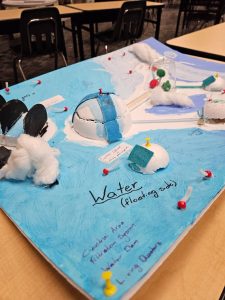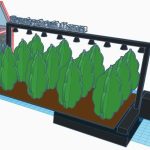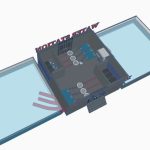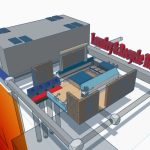Europa Colonization Plan by The Animations
West Island College Calgary-Alberta Canada 14 år gammel 4 / 0 Engelsk Jupiters måner
Projektbeskrivelse
There has always been a goal for colonization of planets or even moons, something that humans can expand and grow on. There have been a lot of speculation on which would be most suitable for life, but we are here for proposition for the moon of Europa around Jupiter. It is abundant with water and elements acceptable for life, but we will have to overcome some obstacles to make sure humans can survive.
Firstly, for the first steps of the colonization plan, we would create a rocket with artificial gravity, water, and a way to generate food on the long trip (2-5 years based on the fuel resources) to Europa. Secondly, once at Europa, we would have attached a large, motorized drill powered by a nuclear-fusion reactor; the drill is controlled by a set of controls and camera. For some details, this drill has a supportive deep, wide, jagged continuous tread to roam its icy surface, with titanium metal on the outside of the interior skeleton to protect the insides and core. The nuclear core produces enough heat to make sure nothing freezes at the surface’s sub-zero temperatures. Once it finds a good place to colonize, one with no rampant or unpredictable geysers, it would drill into the ice until it penetrates water below the surface. Because the water sits at a calm, 0 to –4 degrees Celsius, the temperature issue under the surface is not too difficult to manage. When building the components of the colony, we would place the colony anchored to the ice above, which would keep us stable and suspended while a turbine-powered, hydroelectric dam would use the tides of the water for energy. we would set up a few areas. Two being for living and activity, one for the distillation, desalination, and the electrolysis of water, one for food production through hydroponics, and the last for pressure control, excess water, oxygen, and electricity, and artificial gravity. For water, we use the distillation plant to purify the salty water of the toxic minerals, allowing for fresh drinking water. For air inside the colony, we would use electrolysis to spilt the water molecules into oxygen molecules, then spreading it through the colony. Other elements would be introduced like nitrogen and carbon dioxide to make the quality of air safe to breathe. Food would be produced from the use of hydroponics; though we would use artificial lights, nitrogen, and carbon dioxide to allow for photosynthesis as well. Temperature would not be too big of a problem as the water underneath the surface averages from 0 to –4 as already stated. Microgravity would be handled using artificial gravity, or through intense exercises to keep bone density at a peak. The radiation problem would not affect our colony under the surface, though if in low exposures, it would be quite harmful.
In conclusion, although the process of colonization would take long amounts of time and time to overcome obstacles, it would be great for supporting life. With enough resources and development, we could colonize Europa and live on there as a successful source of life. Although there may be many planets and moons that could support life, ones far in the galaxy of space dust, which one do you think would be the most successful for life?
#3D-design
Andre projekter
Titel: Futuristisk designprojekt for rumlejr på Jupiters måne, Europa
Rio de Janeiro - Brasilien























